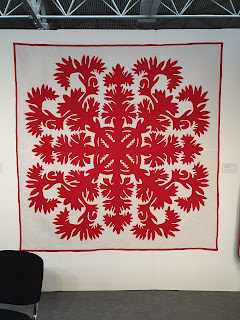This is a very unusual or strange strippy! It is rather tatty and worn, and was not expensive, but it had nice quilting, and, I was curious to see how it was constructed.
Although I have seen one or two wavy strippies, I have never seen anything like this.
The green stripes are applied onto the pink fabric by machine with white piping and are not applique.
Just to show the underside of the piping.
The green stirpes have a running feather and a pattern in the bulges. The quilting is nicely done and the lines of quilting are very close, sometimes indication an older quilt.
The pink stripes have a feather pattern with chevrons, again closely quilted, in the waves.
At the edge of the quilt where it is very worn, you can see that the pink stripes are as normal, but that the green fabric overlaps the pink at its edges. The centre of the green fabric is a single layer.
Another photo to show how the green fabric overlays the pink fabric; the double layers of cotton fabric at the margins did not seem to cause the quilter any problems in her quilting.
The seller was from Pontefract, and the quilt was from her mother in law's estate. Mother in law liked to go to boot sales in the North, so the quilt could have come from anywhere.
Our only thought is, that the maker of the quilt was more comfortable with piping than applique!









































